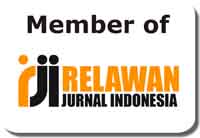The Communicative Function of Non-Face Emoji "Folded Hands" in WhatsApp Interaction among Indonesians
Abstract
This study aimed to examine the communicative functions of the non-face “folded hands” emoji that Indonesians use in WhatsApp interactions. Using descriptive qualitative, the data were analysed through the social semiotic approach proposed by Lemke (1998), the interactional sociolinguistic theory (Gumperz, 1982), and speech act theory. The data were taken from the messages that occurred naturally in several WhatsApp groups. It was re-transcribed and translated in English based on the theory by Dresner and Herring (2010). The findings revealed some functions of the non-face “folded hands” emoji in online communication. At the end of an utterance, it emphasizes message tone, politeness, and soft interaction. Furthermore, rather than this emoji expresses an emotion such as face emoji does, it performs illocutionary forces in communication such as thanking, apologizing, and asking. It is also performed in situational interaction in which the relation of speaker and interlocutor has a formal relation such as teacher-students and leader-staffs. This empirical research added to computer-mediated discourse literature by analyzing the communicative function of folded hands emoji in written discourse. Practically, it might help users interpret the emoji as an abstract concept in the messages.
Keywords
Full Text:
PDFReferences
Al Rashdi, F. (2018). Functions of emojis in WhatsApp interaction among Omanis. Discourse, Context and Media, 26, 117–126.
https://doi.org/10.1016/j.dcm.2018.07.001
Albawardi, A. (2018). The translingual digital practices of Saudi females on WhatsApp. Discourse, Context and Media, 25, 68–77.
https://doi.org/10.1016/j.dcm.2018.03.009
Aull, B. (2019). A study of phatic emoji use in WhatsApp communication. Internet Pragmatics, 2(2), 206–232. https://doi.org/10.1075/ip.00029.aul
Bai, Q., Dan, Q., Mu, Z., & Yang, M. (2019). A systematic review of emoji: Current research and future perspectives. Frontiers in Psychology, 10(October). https://doi.org/10.3389/fpsyg.2019.02221
Brown, G., & Yule, G. (1983). Discourse Analysis: Cambridge Textbooks in Linguistics. Cambridge University Press.
Coyle, M. A., & Carmichael, C. L. (2019). Perceived responsiveness in text messaging: The role of emoji use. Computers in Human Behavior, 99(April), 181–189. https://doi.org/10.1016/j.chb.2019.05.023
Cruz, M. P. (2015). Pragmatics and Discourse Analysis. The Encyclopedia of Applied Linguistics, (August), 1–6. https://doi.org/10.1002/9781405198431.wbeal1463
Darics, E. (2013). Non-verbal signalling in digital discourse: The case of letter repetition. Discourse Context Media, 2(3), 141–148.
Dresner, E., & Herring, S. C. (2010). Functions of the nonverbal in CMC: Emoticons and illocutionary force. Communication Theory, 20(3), 249–268.
https://doi.org/10.1111/j.1468-2885.2010.01362.x
Evans, V. (2017). The emoji code: How smiley faces, love hearts and thumbs up are changing the way we communicate. Michael O’Mara.
Fane, J. (2017). Using emoji as a tool to support child wellbeing from a strengths-based approach. Learning Communities: International Journal of Learning in Social Contexts, 21, 96–107. https://doi.org/10.18793/lcj2017.21.08
Fitriah, F., & Hidayat, D. N. (2018). Politeness: Cultural dimensions of linguistic choice. Indonesian Journal of English Education, 5(1), 26–34.
Geyer, N. (2008). Discourse and Politeness: Ambivalent Face in Japanese. New York: Bloomsbury Publishing.
Gibson, W., Huang, P., & Yu, Q. (2018). Emoji and communicative action: The semiotics, sequence and gestural actions of ‘face covering hand.’ Discourse, Context and Media, 26, 91–99. https://doi.org/10.1016/j.dcm.2018.05.005
Gumperz, J. (1982). Discourse Strategies. Cambridge University Press.
Halliday, M. A. ., & Hasan, R. (1989). (Language Education) M. A. K. Halliday, Ruqaiya Hasan, Frances Christie - Language, Context, and Text_ Aspects of Language in a Social-Semiotic Perspective -Oxford University Press, USA (1989).pdf (p. 71). p. 71.
Haucsa, G. M., Marzuki, A. G., Alek, A., & Hidayat, D. N. (2020). Illocutionary Speech Acts analysis in Tom Cruise’s interview. Academic Journal Perspective : Education, Language, and Literature, 8(1), 11–19.
https://doi.org/10.33603/perspective.v8i1.3304
Herring, S., & Dainas, A. (2017). “Nice Picture Comment!” Graphicons in Facebook Comment Threads. Proceedings of the 50th Hawaii International Conference on System Sciences (2017), (January). https://doi.org/10.24251/hicss.2017.264
Jaeger, S. R., Xia, Y., Lee, P. Y., Hunter, D. C., Beresford, M. K., & Ares, G. (2018). Emoji questionnaires can be used with a range of population segments: Findings relating to age, gender and frequency of emoji/emoticon use. Food Quality and Preference, 68, 397–410. https://doi.org/10.1016/j.foodqual.2017.12.011
Jaipal, K. (2010). Meaning making through multiple modalities in a biology classroom: A multimodal semiotics discourse analysis. Science Education, 94(1), 48–72. https://doi.org/10.1002/sce.20359
Khandekar, S., Ryu, C. W., Higgs, J., Talton, J. O., Bian, Y., & Kumar, R. (2019). OPICO: A study of emoji-first communication in a mobile social app. The Web Conference 2019 - Companion of the World Wide Web Conference, WWW 2019, 18(June), 450–458. https://doi.org/10.1145/3308560.3316547
Lemke, J. (1998). Multiplying meaning: Visual and verbal semiotics in scientific text. Reading Science: Critical and Functional Perspectives on Discourses of Science, 87–113. https://doi.org/10.4324/9780203982327-17
Levinson, S. C. (1983). Pragmatics. Cambridge University Press.
Lim, S. S. (2015). On stickers and communicative fluidity in social media. Social Media and Society, 1(1), 1–3. https://doi.org/10.1177/2056305115578137
Lo, S. (2008). The nonverbal communication functions of emoticons in computer-mediated communication. CyberPsychology & Behavior, 11(5), 595–597. https://doi.org/10.1089/cpb.2007.0132
Novak, P. K., Smailović, J., Sluban, B., & Mozetič, I. (2015). Sentiment of emojis. PLoS ONE, 10(12), 1–21. https://doi.org/10.1371/journal.pone.0144296
Riordan, M. A. (2017). The communicative role of non-face emojis: Affect and disambiguation. Computers in Human Behavior, 76, 75–86.
https://doi.org/10.1016/j.chb.2017.07.009
Thompson, D., & Filik, R. (2016). Sarcasm in written communication: Emoticons are efficient markers of intention. Journal of Computer-Mediated Communication, 21(2), 105–120. https://doi.org/10.1111/jcc4.12156
Trisnani, T. (2017). Pemanfaatan WhatsApp sebagai media komunikasi dan kepuasan dalam penyampaian pesan di kalangan tokoh masyarakat. Jurnal Komunika: Jurnal Komunikasi, Media Dan Informatika, 6(3), 1–12.
https://doi.org/10.31504/komunika.v6i3.1227
Wahyuni, R., & Budi, I. (2018). Combining Linguistic, Semantic and Lexicon Feature for Emoji Classification in Twitter Dataset. Procedia Computer Science, 135, 194–201. https://doi.org/10.1016/j.procs.2018.08.166
Zhou, R., Hentschel, J., & Kumar, N. (2017). Goodbye text, hello emoji: Mobile communication on WeChat in China. Conference on Human Factors in Computing Systems - Proceedings, 2017-May, 748–759.
https://doi.org/10.1145/3025453.3025800
DOI: http://dx.doi.org/10.31332/lkw.v7i1.2374
Copyright (c) 2021 Muhammad Muzakky, Didin Nuruddin Hidayat, Alek Alek

This work is licensed under a Creative Commons Attribution-ShareAlike 4.0 International License.
Langkawi: Journal of The Association for Arabic and English indexed by:



















.png)
.png)

.png)
2.png)








